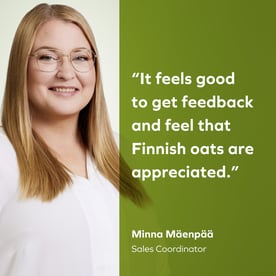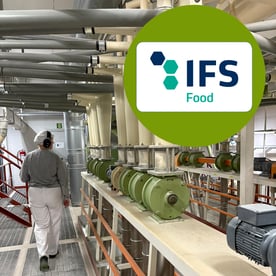”The large grain size of Oats 2.0 tastes great”
This year's harvest of Oats 2.0 is of top quality.
–The effects of variety selection, crop rotation and precision fertilisation became tangible during the threshing phase, says contract farmer Mikko Mäki-Latvala, whose dryer runs on renewable energy.
In the first week of September, flags were flown at Ilmajoki, Mäki-Latvala Farm, both in honour of Finnish food (September 4) and on entrepreneur's day (September 5). On the roof of a modern dryer dressed in a Jussi shirt, at a height of 25 metres on a hot, calm summer day, the Produce of Finland flag waved. As it has been every day since 2018, when the dryer powered by Finnish biofuel was completed.
After the heavy rains at the turn of August and September, Mikko really welcomed the rainy days at the end of the record-breaking hot summer.
– Even though threshing started already on August 6, there are still late varieties to thresh. Now we are waiting for the flood to subside and for the field to be able to withstand the use of machines. The rye that had already sprouted, sown in place of the barley that had already been threshed, was also submerged, Mikko told the news at the beginning of September, when 10 hectares of Oat 2.0 were still unthreshed.
– The last Oats 2.0 were threshed at dusk on September 16.
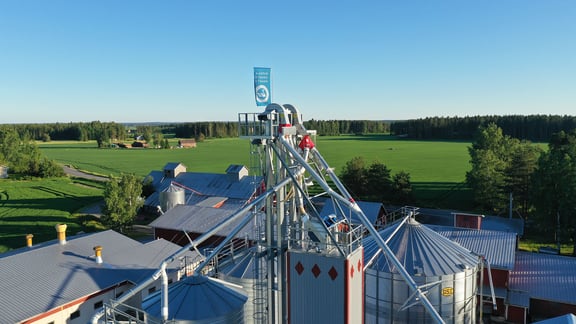
The smartly grown Oats 2.0 will also be polished ecologically. "Since 2018, all grain on our farm has been dried in a dryer that runs on Finnish biofuel," says contract farmer Mikko Mäki-Latvala. At the top of the dryer, at the height of 25 metres, the Produce of Finland flag waves in the wind, come rain or sunshine.
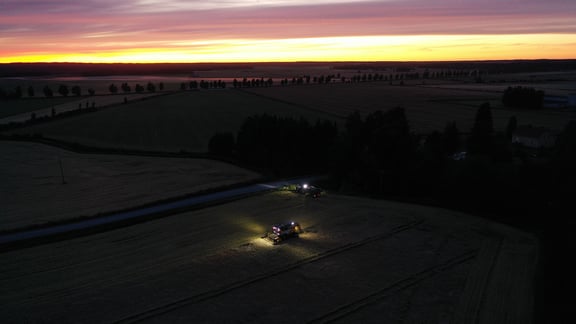
The last Oats 2.0 of the 2024 harvest season were threshed at dusk on Monday 16.9., when rain was promised for the next day. Barley threshing at the Mäki-Latvala farm started already at the beginning of August. Oats 2.0 completed the 1.5-month contract.
After a scorching drought, clouds and just the right amount of rain – before the flood
The early summer indicated that this harvest season would be record-breaking – after all, the speed of growth is determined by heat. But solar radiation is also needed. Despite the hot weather, the summer has been cloudy in Ilmajoki.
– The straw of oats ripen really slowly. Even though the grains were ready, the straw was still green, which slowed down threshing. On the other hand, if the oats overripen, the grains will crumble into the field. Fortunately, current, advanced varieties tolerate even rainy growing seasons better, says Mikko.
Until the beginning of September, the growing conditions were favourable in all respects: even the rains came as if according to the textbook.
– So much so that some varieties tried to "run over" certain growth stages, such as making side shoots that are important for the oat harvest, Mikko explains using an example.
– One weekend's heavy rain was a strange plot twist. But it is also in the name of the game that in the middle of the best threshing season, 160 millimetres of water pours down in one go. It laid our fields flat, but precision fertilization has supported Oats 2.0 to withstand such surprises.
Mill already sent their thanks for top quality
Compared to the five-year statistics of the Mäki-Latvala farm, the 2024 harvest season exceeded the average.
– I'm happy with the harvest. Especially the late varieties yielded good yields, says Mikko. –However, there is a risk that threshing will fall under the autumn rains.
For Oats 2.0, the harvest volume will be better than in 2023.
– Already when choosing the variety, we have aimed for large grains, which affect both the taste and mouthfeel of the porridge. The large-grained, late-fall variety works well against grain mould toxins. The quality and quantity of the crop are also affected by crop rotation and precision fertilisation, Mikko lists the measures for smarter farming.
– According to the grain samples received by the mill and our laboratory studies, Mäki-Latvala Farm’s 2024 harvest season Oats 2.0 are of top quality, confirms Pekka Kultti, Purchasing Manager of grain at Helsinki Mills.
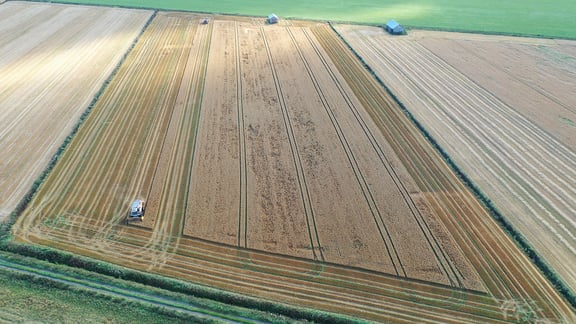
"According to the grain samples received by the mill and our laboratory studies, Mäki-Latvala Farm’s 2024 harvest season Oats 2.0 are of top quality," says Pekka Kultti, Grain Purchasing Manager at Helsinki Mills.
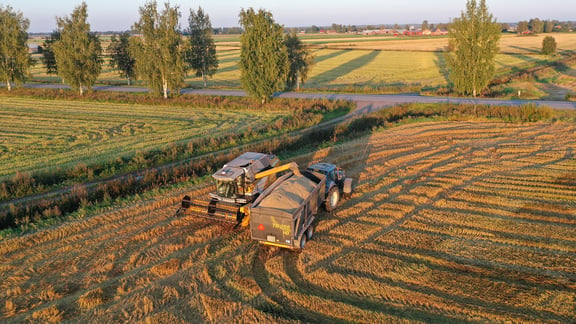
The goal of our farming programme is to obtain a bigger and higher quality crop also during challenging years and in changing climates, while at the same time developing more environmentally friendly farming.
Manual work before the harvester and dryer
After precision fertilisation at the turn of June–July, Mikko set foot on the Oat 2.0 fields in mid-July.
– Wild oats cannot be chemically controlled. In statutory inspections of wild oats, it is important to find and weed out each individual wild oats, as even one individual can produce hundreds of seeds that remain germinating in the ground for years. You need to pay close attention to notice them, as wild oats differ from oats only by a slight nuance of appearance.
On a busy summer day, this means that Mikko's smartwatch shows up to 400% activity when he is taking care of "two birds with one stone" in the oat field.
– At the same time, vegetation monitoring was carried out. The precision fertilizations of Oats 2.0 had yielded good results, and the plant had liked the abundance of rainy days during the growing season. When you walk the fields, you can see what is happening. And the scenery is also nice, Mikko praises the working conditions.
Oats 2.0 dry with Finnish biofuel
The goal of Helsinki Mills' sustainable farming programme, launched in 2022, is to achieve better yields with less pollutant load. At the Mäki-Latvala farm, the pollutant load of agriculture has been critically examined for decades.
–Since 2010, wood chips have formed part of the dryer's energy source, and our new dryer, completed in 2018, uses exclusively domestic biofuel. I am very pleased with the new dryer, which lightens the pollutant load and is more economical than dryers that run on fuel oil.
Logging residues, bushes on the edges of fields, cleaning debris from the drying process... all this is put to good use at the Mäki-Latvala farm to create the energy needed. Both the house and the production facilities are heated with wood chips.
–On summer days, we are completely energy self-sufficient, as in 2018 we also invested in a solar power plant with 146 panels, said Mikko.
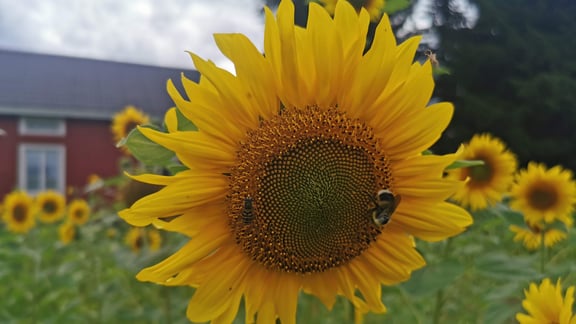
Nothing basic here! The pollinator lanes included in the Oat 2.0 farming programme delight both buzzy bugs and people passing by. Flowering plants at Mäki-Latvala Farm also play a significant role in crop rotation by improving the growing condition of the fields and reducing the need for protective substances and fertilisation.
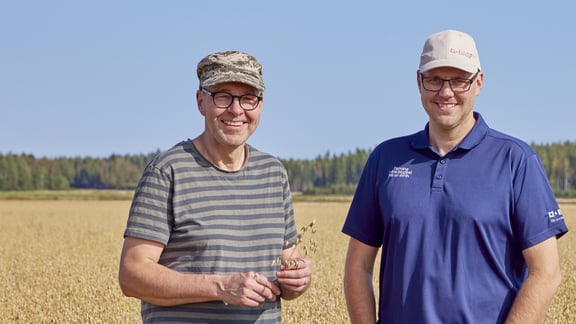
Veikko (left) and Mikko Mäki-Latvala have already prepared for the 2025 harvest season in Ilmajoki. "Peas, which store nitrogen in the soil, will make room for Oats 2.0 in the next crop rotation," says Mäki-Latvala.
Pea laid the foundation for Oats 2.0 for the 2025 harvest season
The exceptionally early threshing at the beginning of August means that the 2025 harvest season also started early. In the early days of September, Mikko estimated that he would be ready for threshing within a few weeks. Of the flowering plants, rapeseed had already been threshed before mid-September. Oats 2.0 ended the threshing on September 16.
– Sometimes we have harvested rapeseed from fields covered with the first snow, so we have even experienced sideslips while driving the harvester.
At the Mäki-Latvala farm, autumn crops had sprouted at the beginning of September. The catch crops that were kept over the winter had started to grow spectacularly. The preparations for the harvest of 2025 Oats 2.0 lasted the entire 2024 season, when peas, which store nitrogen in the soil, will make room for oats in the next crop rotation.
– Some of the fields overwinter covered with plants, while others are lightly tilled already in the autumn so that we can begin sowing in early spring. Nature management fields are mowed. Liming is done either in autumn or early winter, Mikko explained the farmer's to-do list.
Even the field work done after threshing is carried out thoughtfully and ecologically.
– Tyres and tyre pressure play a big role when it comes to preserving both field and fuel. The lower the tyre pressure, the gentler it is on the soil, says Mikko Mäki-Latvala.
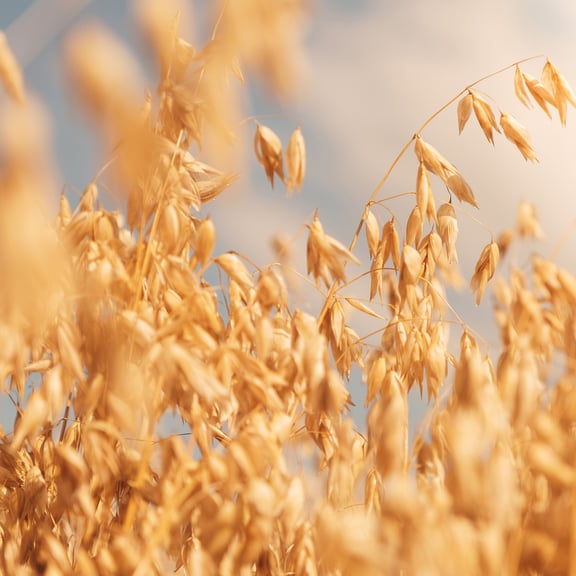
Better quality harvest in a changing climate
In 2022, Helsinki Mills launched a practical environmental programme with its contract farmers, the aim of which is to improve grain quality, increase crop levels and crop certainty, and at the same time reduce the environmental impact of farming.
- The important things for our family business are domesticity and transparency. Our vision is sustainable agriculture that benefits both people and nature.
- Together with our contract farmers, we secure the supply of raw materials and the future of food production.
- Our goal is to get a bigger and higher quality crop also during challenging years and in changing climates, while at the same time developing more environmentally friendly farming.
This future farming method supports biodiversity and makes oats tastier. Now everyone wins – the farmer, the soil, the buzzy bugs and, of course, the porridge eater. We're glad you've decided to choose the winners' side!


